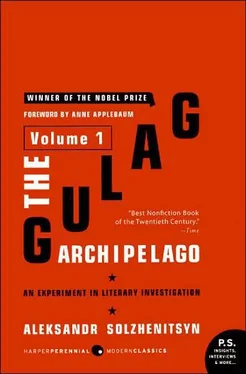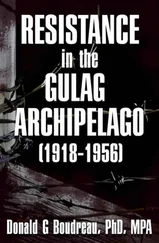As early as 1921 interrogations usually took place at night. At that time, too, they shone automobile lights in the prisoner’s face (the Ryazan Cheka—Stelmakh). And at the Lubyanka in 1926 (according to the testimony of Berta Gandal) they made use of the hot-air heating system to fill the cell first with icy-cold and then with stinking hot air. And there was an airtight cork-lined cell in which there was no ventilation and they cooked the prisoners. The poet Klyuyev was apparently confined in such a cell and Berta Gandal also. A participant in the Yaroslavl uprising of 1918, Vasily Aleksandrovich Kasyanov, described how the heat in such a cell was turned up until your blood began to ooze through your pores. When they saw this happening through the peephole, they would put the prisoner on a stretcher and take him off to sign his confession. The “hot” and “salty” methods of the “gold” period are well known. And in Georgia in 1926 they used lighted cigarettes to burn the hands of prisoners under interrogation. In Metekhi Prison they pushed prisoners into a cesspool in the dark.
There is a very simple connection here. Once it was established that charges had to be brought at any cost and despite everything, threats, violence, tortures became inevitable. And the more fantastic the charges were, the more ferocious the interrogation had to be in order to force the required confession. Given the fact that the cases were always fabricated, violence and torture had to accompany them. This was not peculiar to 1937 alone. It was a chronic, general practice. And that is why it seems strange today to read in the recollections of former zeks that “torture was permitted from the spring of 1938 on.” [57] 7. Y. Ginzburg writes that permission for “physical measures of persuasion” was given in April, 1938. V. Shalamov believes that tortures were permitted from the middle of 1938 on. The old prisoner M ch is convinced that there was an “order to simplify the questioning and to change from psychological methods to physical methods.” Ivanov-Razumnik singles out the middle of 1938 as the “period of the most cruel interrogations.”
There were never any spiritual or moral barriers which could have held the Organs back from torture. In the early postwar years, in the Cheka Weekly, The Red Sword, and Red Terror, the admissibility of torture from a Marxist point of view was openly debated. Judging by the subsequent course of events, the answer deduced was positive, though not universally so.
It is more accurate to say that if before 1938 some kind of formal documentation was required as a preliminary to torture, as well as specific permission for each case under investigation (even though such permission was easy to obtain), then in the years 1937-1938, in view of the extraordinary situation prevailing (the specified millions of admissions to the Archipelago had to be ground through the apparatus of individual interrogation in specified, limited periods, something which had simply not happened in the mass waves of kulaks and nationalities), interrogators were allowed to use violence and torture on an unlimited basis, at their own discretion, and in accordance with the demands of their work quotas and the amount of time they were given. The types of torture used were not regulated and every kind of ingenuity was permitted, no matter what.
In 1939 such indiscriminate authorization was withdrawn, and once again written permission was required for torture, and perhaps it may not have been so easily granted. (Of course, simple threats, blackmail, deception, exhaustion through enforced sleeplessness, and punishment cells were never prohibited.) Then, from the end of the war and throughout the postwar years, certain categories of prisoners were established by decree for whom a broad range of torture was automatically permitted. Among these were nationalists, particularly the Ukrainians and the Lithuanians, especially in those cases where an underground organization existed (or was suspected) that had to be completely uncovered, which meant obtaining the names of everyone involved from those already arrested. For example, there were about fifty Lithuanians in the group of Romualdas Skyrius, the son of Pranus. In 1945 they were charged with posting anti-Soviet leaflets. Because there weren’t enough prisons in Lithuania at the time, they sent them to a camp near Velsk in Archangel Province. There some were tortured and others simply couldn’t endure the double regime of work plus interrogation, with the result that all fifty, to the very last one, confessed. After a short time news came from Lithuania that the real culprits responsible for the leaflets had been discovered, and none of the first group had been involved at all! In 1950, at the Kuibyshev Transit Prison, I encountered a Ukrainian from Dnepropetrovsk who had been tortured many different ways in an effort to squeeze “contacts” and names out of him. Among the tortures to which he had been subjected was a punishment cell in which there was room only to stand. They shoved a pole inside for him to hold on to so that he could sleep—for four hours a day. After the war, they tortured Corresponding Member of the Academy of Sciences Levina because she and the Alliluyevs had acquaintances in common.
It would also be incorrect to ascribe to 1937 the “discovery” that the personal confession of an accused person was more important than any other kind of proof or facts. This concept had already been formulated in the twenties. And 1937 was just the year when the brilliant teaching of Vyshinsky came into its own. Incidentally, even at that time, his teaching was transmitted only to interrogators and prosecutors—for the sake of their morale and steadfastness. The rest of us only learned about it twenty years later—when it had already come into disfavor—through subordinate clauses and minor paragraphs of newspaper articles, which treated the subject as if it had long been widely known to all.
It turns out that in that terrible year Andrei Yanuaryevich (one longs to blurt out, “Jaguaryevich”) Vyshinsky, availing himself of the most flexible dialectics (of a sort nowadays not permitted either Soviet citizens or electronic calculators, since to them yes is yes and no is no), pointed out in a report which became famous in certain circles that it is never possible for mortal men to establish absolute truth, but relative truth only. He then proceeded to a further step, which jurists of the last two thousand years had not been willing to take: that the truth established by interrogation and trial could not be absolute, but only, so to speak, relative. Therefore, when we sign a sentence ordering someone to be shot we can never be absolutely certain, but only approximately, in view of certain hypotheses, and in a certain sense, that we are punishing a guilty person. [58] 8. Perhaps Vyshinsky, no less than his listeners, needed this ideological comfort at this time. When he cried out from the prosecutor’s platform: “Shoot them all like mad dogs!” he, at least, who was both evil and quick of mind, understood that the accused were innocent. And in all probability he and that whale of Marxist dialectics, the defendant Bukharin, devoted themselves with all the greater passion to the dialectical elaboration of the judicial lie: for Bukharin it was too stupid and futile to die if he was altogether innocent (thus he needed to find his own guilt!); and for Vyshinsky it was more agreeable to see himself as a logician than as a plain downright scoundrel.
Thence arose the most practical conclusion: that it was useless to seek absolute evidence—for evidence is always relative—or unchallengeable witnesses—for they can say different things at different times. The proofs of guilt were relative, approximate, and the interrogator could find them, even when there was no evidence and no witness, without leaving his office, “basing his conclusions not only on his own intellect but also on his Party sensitivity, his moral forces” (in other words, the superiority of someone who has slept well, has been well fed, and has not been beaten up) “and on his character” (i.e., his willingness to apply cruelty!).
Читать дальше












